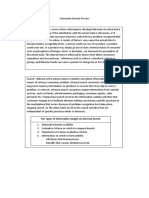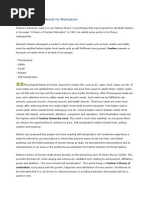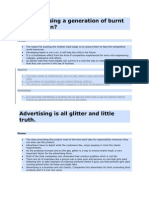The Buying Decision Process
The Buying Decision Process
Uploaded by
Abdullah FaisalCopyright:
Available Formats
The Buying Decision Process
The Buying Decision Process
Uploaded by
Abdullah FaisalCopyright
Available Formats
Share this document
Did you find this document useful?
Is this content inappropriate?
Copyright:
Available Formats
The Buying Decision Process
The Buying Decision Process
Uploaded by
Abdullah FaisalCopyright:
Available Formats
The Buying Decision Process- Five Stage Model
The consumer decision-making process follows the stages shown in Figure. Problem recognition - Problem recognition arises when the consumer realizes that there is a need for some item. This can come about through assortment depletion (where the consumers stock of goods has been used up or worn out) or assortment extension (which is where the consumer feels the need to add some new item to the assortment of possessions). At this point the consumer has only decided to seek a solution to a problem, perhaps by buying a category of product. The needs felt can be categorized as either utilitarian (concerned with the functional attributes of the product) or hedonic (concerned with the pleasurable or aesthetic aspects of the product). The current view is that there is a balance between the two types of need in most decisions. An internal stimulus, or drive, comes about because there is a gap between the actual and desired states. Drives are generated by encouraging a revision of the desired state. The higher the drive level (i.e. the greater the gap between actual and desired states), the more open the individual is to considering new ways of satisfying the need: in simple terms, a starving man will try almost any kind of food. It is, of course, stimulating and enjoyable to allow gaps to develop between the desired and actual states. Each individual has an optimal stimulation level (OSL), which is the point at which the drive is enjoyable and challenging, without being uncomfortable. OSL is subjective: research shows that those with high OSLs like novelty and risk-taking, whereas those with low OSLs prefer the tried and tested. Those with high OSLs also tend to be younger. Drives lead on to motivation, which is the reason why people take action. The level of motivation will depend on the desirability of the end goal, and the ease of achieving the end goal; motivations are subjective, so it is difficult to infer motivation from behavior. Information search - Having become motivated to seek a solution to the need problem, consumers engage in two forms of information search.
The internal search involves remembering previous experiences of the product category, and thinking about what he/she has heard about the product category. The external search involves shopping around, reading manufacturers literature and advertisements, and perhaps talking to friends about the proposed purchase.
The purpose of this exercise is to reduce risk; buying the wrong brand of biscuits involves very little risk, since the financial commitment is low, but buying the wrong hi-fi could prove to be an expensive mistake. Evaluation of alternatives - Having found out about several competing brands, the consumer will evaluate the alternatives, based on the information collected or remembered. In the first instance, the consumer will select a consideration set, which is the group of products that would most closely meet the need. Typically a consumer will use cut-offs to establish a consideration set: these are the minimum and maximum acceptable values for the product characteristics. Signals are important when making choices; a particular price-tag, a brand name, even the retailer will have some effect on the consumers perception of the product. Price is frequently used as an indicator of quality, for example, but this can be reduced in the presence of other signals.
Occasionally the use of cut-offs eliminates all the possibilities from the consideration set, in which case the consumer will have to revise the rules. This can result in the creation of a hierarchy of rules. For marketers, the challenge is often to ensure that the product becomes a member of the consideration set. The decision-making process appears lengthy and complex as stated here, yet most of us make several purchasing decisions in a day without going through a lengthy decisionmaking process. This is because most of us use heuristics, or decision-making rules, for most purchases. These are simple if . . . then rules that reduce risk by using previous experience as a guide. Heuristics divide into three categories:
* Search heuristics, which are concerned with rules for finding out information; * Evaluation heuristics, which are about judging product offerings; and * Choice heuristics, which are about evaluation of alternatives.
The decision-making process may contain a number of interrupts points at which the search is temporarily suspended. Interrupts come in four categories:
* Environmental stimuli, which include in-store promotions (perhaps eye-catching posters for other products); * Affective states, which include physiological needs (the sudden need to go to the toilet, or to have a coffee); * Unexpected information, for example a change of layout in the shop or some change in the product attributes; and * Conflicts, which occur when the consumer realizes that the original decision making plan cannot be followed, or an alternative plan appears that is not consistent with the original plan.
For example, an approachapproach conflict occurs when a second product is presented that would probably do the job just as well. This means that the consumer has to make a comparison, and the search pattern is temporarily suspended. An approachavoidance conflict might arise when the consumer finds out the product is much more expensive than expected; an avoidanceavoidance conflict might arise when the two alternatives are equally distasteful. The effect of the interrupt will depend on the consumers interpretation of the event. Sometimes the interrupt activates a new end goal, or perhaps a new choice heuristic might be activated. Sometimes the interrupt is serious enough for the search to be abandoned altogether; here the strength of the interrupt is important. Clearly a sudden desire for a cup of tea will not permanently interrupt a search process, but the news that one has lost ones job very well might.
In most cases, consumers will resume the interrupted problem-solving process once the stimulus has been absorbed and accepted or rejected.
Purchase - The actual purchase comes next; the consumer will locate the required brand, and perhaps choose a retailer he or she has faith in, and will also select an appropriate payment method.
Post-purchase evaluation - Post-purchase evaluation refers to the way the consumer decides whether the product purchase has been a success or not. This process usually involves a comparison between what the consumer was expecting to get, and what was actually purchased, although sometimes new information obtained after the purchase will also color the consumers thinking. Before the purchase, the consumer will have formed expectations of the products capabilities in terms of
* Equitable performance (what can be reasonably expected given the cost and effort of obtaining the product); * Ideal performance (what the consumer hopes the product will do); and * Expected performance (which is what the product probably will do).
Sometimes this evaluation leads to post-purchase dissonance, when the product has not lived up to expectations, and sometimes to post-purchase consonance when the product is as expected or better. In either event, the consumer will feed back this information into memory, to inform the internal search for next time. One of the more interesting aspects of dissonance is that there is evidence to show that a small discrepancy between expectation and outcome may provoke a bigger change in attitude than a large discrepancy. This is because a small discrepancy may force the consumer to confront the purchase behaviour without offering a ready explanation for it.
Consumers will usually act to reduce post-purchase dissonance. There are four general approaches to doing this:
Ignore the dissonant information and concentrate on the positive aspects of the product. Distort the dissonant information (perhaps by telling oneself that the product was, after all, the cheap version). Play down the importance of the issue. Change ones behavior.
From a marketing viewpoint, it is generally better to ensure that the consumer has accurate information about the product beforehand so as to avoid post-purchase Consumers express dissatisfaction in one of three ways:
Voice responses, in which the customer comes back and complains; Private responses, in which the consumer complains to friends; and Third-party responses, which may include complaints to consumer organizations, trade associations and TV consumer programmes, or even legal action.
The most effective way of reducing post-purchase dissonance is to provide a product that meets the customers expectations. This is partly a function for the manufacturer, but is also a problem for the retailer to address since it should be possible to ensure that the consumers needs are fully understood before a recommendation about a product is made. As a fall-back position, though, every effort should be made to encourage the consumer to complain if things do not come up to expectations. This is why waiters always ask if the meal is all right, and why shops frequently have no-quibble money-back guarantees. Ferry companies and airlines provide customer comment slips, and some marketers even make follow-up telephone calls to consumers to check that the product is meeting expectations.
You might also like
- Ahead of the Curve: Using Consumer Psychology to Meet Your Business GoalsFrom EverandAhead of the Curve: Using Consumer Psychology to Meet Your Business GoalsNo ratings yet
- Buying Decision ProcessDocument7 pagesBuying Decision ProcessEkaur KaurNo ratings yet
- TCET FE EPC Resource Book (2020-2021)Document286 pagesTCET FE EPC Resource Book (2020-2021)Kevin100% (1)
- Psycho-Education For Teachers: Understanding The Child Guidance Process Part 1 - Definition, Elements, and StepsDocument8 pagesPsycho-Education For Teachers: Understanding The Child Guidance Process Part 1 - Definition, Elements, and StepsThe Psycho-Educational Teacher100% (1)
- Alternative Evaluation Decision Rules-And-Purchase DecisionDocument22 pagesAlternative Evaluation Decision Rules-And-Purchase Decisionjakhar30No ratings yet
- CB Assignment01Document8 pagesCB Assignment01Hira RazaNo ratings yet
- The Role of Advertising in The Purchase Decision ProcessDocument6 pagesThe Role of Advertising in The Purchase Decision Processjj9821No ratings yet
- 4 PDFDocument5 pages4 PDFHani Bin Faisal AhammadNo ratings yet
- Consumer Behaviour and Rural Marketing AssignmentDocument15 pagesConsumer Behaviour and Rural Marketing Assignmentjainpiyush_1909No ratings yet
- The Consumer Decision Making Process Consists of The Following StagesDocument29 pagesThe Consumer Decision Making Process Consists of The Following StagesSHIVPRATAPNo ratings yet
- Chapter #2Document7 pagesChapter #2didimosdore16No ratings yet
- How Do Customers Buy?Document5 pagesHow Do Customers Buy?Vikas KhobragadeNo ratings yet
- CB Ch2Document6 pagesCB Ch2shanemathew758No ratings yet
- By DR - Genet Gebre: 5. Consumer Decision Making Process (Mbam 641)Document32 pagesBy DR - Genet Gebre: 5. Consumer Decision Making Process (Mbam 641)Legesse Gudura MamoNo ratings yet
- Chap 3 Problem Regconition (AutoRecovered)Document9 pagesChap 3 Problem Regconition (AutoRecovered)s4023247No ratings yet
- Assignment On Buyers Decision Making ProcessDocument7 pagesAssignment On Buyers Decision Making ProcessPooja Dubey100% (1)
- CBAssignment HoangThuyLinhDocument6 pagesCBAssignment HoangThuyLinhlinhcindyNo ratings yet
- Buying Decision ProcessDocument3 pagesBuying Decision ProcessUsman KhizarNo ratings yet
- Chapter 3Document19 pagesChapter 3olmezestNo ratings yet
- Buyer Decision Making ProcessDocument2 pagesBuyer Decision Making ProcessNikiNo ratings yet
- E-Note 14811 Content Document 20240103110324AMDocument34 pagesE-Note 14811 Content Document 20240103110324AMytmandar29No ratings yet
- Consumer Markets & Buyer BehaviorDocument27 pagesConsumer Markets & Buyer BehaviorKailas SarathNo ratings yet
- Consumer Decision Making - NewDocument29 pagesConsumer Decision Making - NewolmezestNo ratings yet
- Consumer Decision MakingDocument27 pagesConsumer Decision Makingharshbaghel656No ratings yet
- Consumen Decision ProcessDocument3 pagesConsumen Decision ProcessAnissa Amalia SultoniNo ratings yet
- CB Module 1 - Lesson 2-1Document13 pagesCB Module 1 - Lesson 2-1Rodel CamposoNo ratings yet
- My FinalDocument67 pagesMy FinalkaurpreetgillNo ratings yet
- Consumer Behaviour The Purchasing ProcessDocument14 pagesConsumer Behaviour The Purchasing ProcessNeggaz D MapeleNo ratings yet
- Consumer Decisiion MakingDocument4 pagesConsumer Decisiion MakingJitendra SinghNo ratings yet
- Decision Making ProcessDocument30 pagesDecision Making Processvijaymail23No ratings yet
- Consumer Behaviour in Retail Business-2Document23 pagesConsumer Behaviour in Retail Business-2khushi P HNo ratings yet
- Behavioral Decision TheoryDocument6 pagesBehavioral Decision Theorykmymanah01No ratings yet
- NTRODUCTIONDocument8 pagesNTRODUCTIONros_verma07No ratings yet
- Chapter No.9. Consumer Decision Process & Problem RecognitionDocument16 pagesChapter No.9. Consumer Decision Process & Problem RecognitionMichelle Danika MarquezNo ratings yet
- Consumer Buying Behavior Concept - OdtDocument5 pagesConsumer Buying Behavior Concept - OdtPrithviraj KumarNo ratings yet
- The Buying Decision ProcessDocument7 pagesThe Buying Decision ProcessBirhanu DesalegnNo ratings yet
- The Consumer Buying Decision ProcessDocument10 pagesThe Consumer Buying Decision ProcessakmohideenNo ratings yet
- Buying Decision-Upload OneDocument27 pagesBuying Decision-Upload Onearchanashri2748No ratings yet
- Consumer Decision Making Module 5Document15 pagesConsumer Decision Making Module 5abhishekmalusare07No ratings yet
- Consumer MarketingDocument9 pagesConsumer MarketingatlcelebrityNo ratings yet
- UntitledDocument15 pagesUntitledGIFT EDWARD PHIRINo ratings yet
- Consumer Decision Making Process (Reference)Document9 pagesConsumer Decision Making Process (Reference)May Oo LayNo ratings yet
- Customer DetailDocument28 pagesCustomer Detailhiren_shah007No ratings yet
- Consumer BehaviorDocument14 pagesConsumer BehaviorshikhilNo ratings yet
- Buying Behaviour of A CustomerDocument8 pagesBuying Behaviour of A CustomerbhowalchitralekhaNo ratings yet
- Value SystemDocument16 pagesValue Systembisrekifle324No ratings yet
- Consumer Buying Bheaviour BisleriDocument48 pagesConsumer Buying Bheaviour BisleriSiddhant Jagtap40% (5)
- A Study On The Impact of Advertisement in Taking Buying Decision by ConsumerDocument44 pagesA Study On The Impact of Advertisement in Taking Buying Decision by Consumeralok006100% (2)
- Marketing Management - Module 4Document27 pagesMarketing Management - Module 4Genner RazNo ratings yet
- Prinmark CH 6 Consumer Decision MakingDocument7 pagesPrinmark CH 6 Consumer Decision MakingRosemarie MacapagalNo ratings yet
- Chapter 1Document19 pagesChapter 1mohan ksNo ratings yet
- Revision & Consumer Decision MakingDocument37 pagesRevision & Consumer Decision Makingcaitlinroux5No ratings yet
- Consumer 20 BehaviorDocument16 pagesConsumer 20 BehaviorAnti NabilahNo ratings yet
- Marketing Chapter 6Document10 pagesMarketing Chapter 6Chau GiangNo ratings yet
- Lecture 3, Consumer Behaviour RefinedDocument23 pagesLecture 3, Consumer Behaviour RefinedShiro WanjiruNo ratings yet
- Consumer Buying DecisionDocument6 pagesConsumer Buying DecisionRatna Sari UtamiNo ratings yet
- Roxas, Dan - POM - Assignment3Document6 pagesRoxas, Dan - POM - Assignment3DAN CARLO ROXASNo ratings yet
- The Ultimate Product Review Guide: Make Informed Choices and Get the Best Value Every TimeFrom EverandThe Ultimate Product Review Guide: Make Informed Choices and Get the Best Value Every TimeNo ratings yet
- ChatGPT And Neuromarketing - A Practical Guide to Influence Sales with AI: Series 2From EverandChatGPT And Neuromarketing - A Practical Guide to Influence Sales with AI: Series 2No ratings yet
- Create Demand for What You Sell: The 7 High-Impact StrategiesFrom EverandCreate Demand for What You Sell: The 7 High-Impact StrategiesNo ratings yet
- Daniel Pink Sales Persuasion DP - CompleteDocument16 pagesDaniel Pink Sales Persuasion DP - CompleteZsuzsa100% (2)
- You Can WinDocument91 pagesYou Can Winsantoshkumar777100% (4)
- WebenerDocument8 pagesWebenerRehan SabirNo ratings yet
- Case Study AssignmentDocument5 pagesCase Study AssignmentSamirPotale-sylvesterNo ratings yet
- Chapter 9Document18 pagesChapter 9Ibrahim Genc100% (1)
- Investig 8Document14 pagesInvestig 8api-361490645No ratings yet
- Managing Emotional:: For Developing Leadership CompetenceDocument75 pagesManaging Emotional:: For Developing Leadership CompetenceKeith Clarence BunaganNo ratings yet
- Alderfer's ERG TheoryDocument18 pagesAlderfer's ERG TheoryShanine PanaguitonNo ratings yet
- Bore, Samuel K Psycho-Educational Groups in Schools NFJCA V2 N1 2013Document9 pagesBore, Samuel K Psycho-Educational Groups in Schools NFJCA V2 N1 2013Sam LalparlienNo ratings yet
- About Conflict Resolution TheoryDocument13 pagesAbout Conflict Resolution TheorymdkaifahmedNo ratings yet
- Human Resource Management: Unit Code: k/601/1264 Lecturer: Siham Aboujanah Submission Date: 29/07/11 QCF Level 5Document19 pagesHuman Resource Management: Unit Code: k/601/1264 Lecturer: Siham Aboujanah Submission Date: 29/07/11 QCF Level 5Sangeeta SharmaNo ratings yet
- Ethiopian TVET-System: Learning Guide # 1Document25 pagesEthiopian TVET-System: Learning Guide # 1Israel Kifle100% (2)
- SCRIPT On Our ProposalDocument2 pagesSCRIPT On Our ProposalAlyanna EvangelistaNo ratings yet
- Dweck & Leggett (1988) A Social-Cognitive ApproachDocument18 pagesDweck & Leggett (1988) A Social-Cognitive ApproachNicolásAlejandroCortésUaracNo ratings yet
- GCP Harp1003 - Martial LawDocument113 pagesGCP Harp1003 - Martial Lawalexandre.pesantiNo ratings yet
- The Teaching ProfessionDocument3 pagesThe Teaching ProfessionJoniele Angelo AninNo ratings yet
- Calvert 2002 - Academic ResearchDocument17 pagesCalvert 2002 - Academic Researchapi-27028656No ratings yet
- Test Bank For Culture and Psychology 6th Edition by MatsumotoDocument15 pagesTest Bank For Culture and Psychology 6th Edition by MatsumotoRobert Benton100% (39)
- Contemporary Theories of MotivationDocument10 pagesContemporary Theories of MotivationAbdiel AbdullahNo ratings yet
- NURS FPX 6216 Assessment 4 Preparing and Managing A Capital BudgetDocument7 pagesNURS FPX 6216 Assessment 4 Preparing and Managing A Capital Budgetfarwaamjad771No ratings yet
- Brunel University Dissertation ExamplesDocument7 pagesBrunel University Dissertation ExamplesWhoCanWriteMyPaperCanada100% (1)
- Maslow Hierarchy Needs For MotivationDocument1 pageMaslow Hierarchy Needs For MotivationbilmNo ratings yet
- Trading Psychology by Traders Academy (MR - Singh)Document18 pagesTrading Psychology by Traders Academy (MR - Singh)mmmksNo ratings yet
- OrganizationalBehavior HumanRelations 5-31-19Document335 pagesOrganizationalBehavior HumanRelations 5-31-19g5nbNo ratings yet
- Final Copy Bse 2203 Special Education Administration and ManagementDocument10 pagesFinal Copy Bse 2203 Special Education Administration and Managementsalvineobonyo7777No ratings yet
- Are We Raising A Generation of Burnt Out ChildrenDocument6 pagesAre We Raising A Generation of Burnt Out ChildrenDrHarish SharmaNo ratings yet
- Principles and Practices of Management 2013 PDFDocument4 pagesPrinciples and Practices of Management 2013 PDFPushpendra RathoreNo ratings yet
- Institute of Business Administration Principles of Management BBA Course OutlineDocument7 pagesInstitute of Business Administration Principles of Management BBA Course OutlineIrfan BalochNo ratings yet

























































































